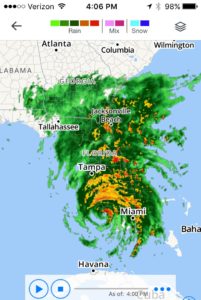
How Hurricane Irma looked on Sunday afternoon.
This will be a hurricane season that residents of Texas and Florida will long remember. Just as Houston began the long process of cleaning up from Hurricane Harvey, Miami and cities on Florida’s west coast were hit full force this weekend by Hurricane Irma.
And no one can yet relax. Hurricane Jose is still on the way.
In each case, citizens had plenty of advance notice if they wanted to leave. They were told that massive flooding was possible, and that strong winds could do serious damage.
And, in each case, the storms revealed a variety of transportation vulnerabilities, from the air to the roads to the rails (or lack of them). Authorities could tell people to go, but they couldn’t make it quick or easy for them to evacuate.
All weekend, there were complaints on social media that gas was scarce for evacuees in Florida, in part because of shortages caused by Harvey.
There have been numerous stories about the number of cars that will have to be declared totaled in Houston due to water damage, with 100,000 insurance claims already filed, and estimates of as many as 1 million lost.
In each case, the storms slammed into parts of the country where public transportation takes a back seat to freeways and cars.
A few weeks back, we told you that a high-speed rail system between Houston and Dallas was moving along in Texas, but it will be years before it will be built.
Miami, meanwhile, has a light-rail system and Miami Beach looks likely to build a streetcar system.
But Tampa, which was right in the path of the storm on Sunday, is the largest American city without some sort of rail-based transit program, and its local transportation is considered by some critics to be the worst in the country.
The cleanup from the hurricanes will give these places an opportunity to consider whether they want to remain dependent on cars or whether it would be wise to give more thought to public transportation.
That’s especially an issue in Houston, where there’s an active debate over whether the city will simply rebuild what was damaged by Harvey, or rethink its zoning ordinances to bar construction in flood zones.
The Houston damage also includes as many as 10,000 new cars at dealerships, and estimates say the total cost for all the lost cars may be as high as $4.9 billion.
There is a bright note. Last week, Houston put its entire METRORail system back into operation, and has restored bus service on all but a handful of routes. Students are being offered free rides on city buses for the rest of September
In Florida, cleanup is days from getting underway, and it may have to wait until it’s clear what kind of damage Jose will do.
_____
We send our best wishes to everyone who’s experienced damage from Harvey and is feeling the brunt of Irma. Stay safe.
